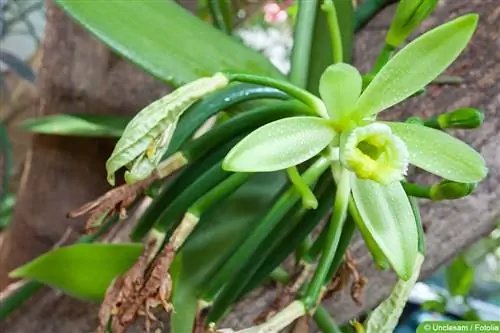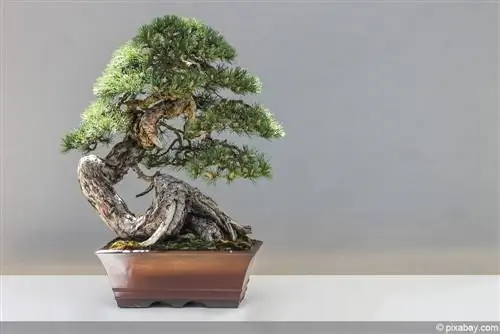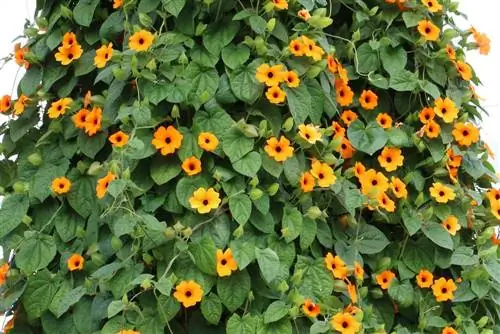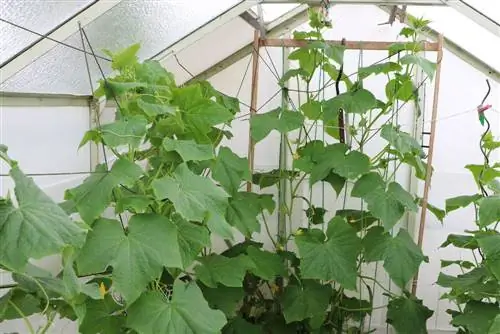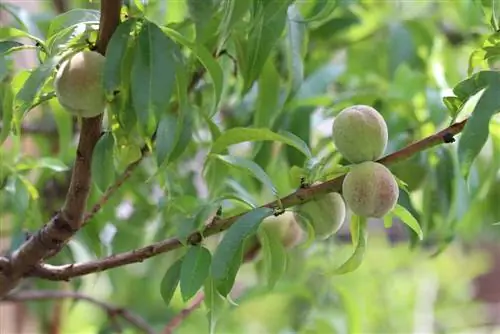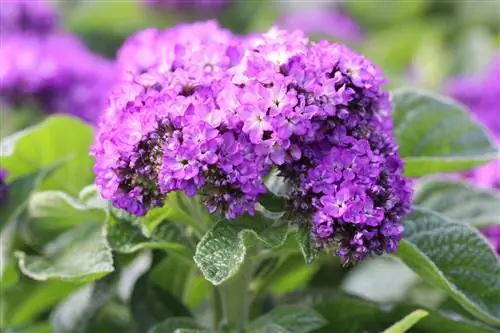- Author admin [email protected].
- Public 2023-12-17 03:39.
- Last modified 2025-01-24 12:45.
If you have decided to cultivate a vanilla plant, you have a lot of work ahead of you. In order for the orchid to bear fruit, care must be tailored precisely to the needs of the plant.
Profile
- Plant family: Orchids (Orchidaceae)
- Genus: Vanilla (Vanilla)
- Synonyms: real vanilla, spiced vanilla, vanilla orchid
- Origin: Central America, mainly Mexico
- is now grown in many tropical areas, especially in Madagascar (bourbon vanilla)
- Growth habit: climbing plant, evergreen, forms long tendrils and aerial roots
- Trail length: up to 1,500 cm
- Flower: up to 8 cm long, orchid flower, yellow-green, aromatic scent
- Leaves: 5 cm to 25 cm, long, short-stemmed, green
- forms usable pods
Location
The location is essential for a he althy vanilla plant. Since Vanilla planifolia is an evergreen tropical plant, you have to adapt the cookie exactly to the needs of the spiced vanilla. The location must have the following properties:
- Light requirement: bright
- avoid direct sun
- Summer temperature: 25°C to 28°C
- Winter temperature: around 20°C
- Humidity: 70 percent to 80 percent
- Optimize humidity with a humidifier or spray bottle
- protect from cold drafts
Since vanilla plants cannot be planted outdoors in Central Europe, you have to use a heated greenhouse. Alternatively, living rooms, winter gardens and bathrooms with a window to the east or west that are not too dark and have the above-mentioned properties in terms of heat and humidity are suitable. Unfortunately, vanilla flowers do not produce flowers indoors. A greenhouse is therefore preferable if you want to try cultivation including harvesting.
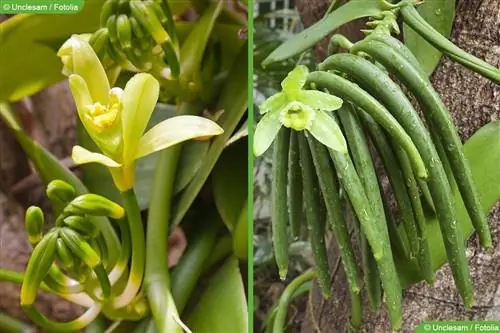
Substrate
Vanilla plants usually only need one large pot for their entire life, as their long tendrils grow upwards while the amount of roots remains quite small. The substrate should be as follows:
- Use high-quality orchid soil
- alternatively mix pine bark and quality soil
- air permeable
- crumbly structure
- Put plant in substrate
- Do not press the substrate, just arrange it slightly around the roots
- Equip the pot with a climbing aid
- Trail should not be too small
Tip:
Alternatively, you can repot your Vanilla planifolia in a hanging basket. No trellis is needed for this because the tendrils can hang down in a relaxed manner.
Pouring
Moisture is important not only in relation to the location. The substrate must not dry out, otherwise the vanilla plant will die, which is evident from withered leaves. Waterlogging should also be avoided, otherwise the plant will rot from the inside out. As soon as you notice a musty smell from the substrate and the plant weakens, it is a case of waterlogging. To find the right balance, you need to pay attention to certain points when pouring the vanilla:
- use only low-lime water
- Rain, filter or stale water are suitable
- Temperature: lukewarm or room temperature
- only water the substrate as necessary
- Check water requirements with a finger test
- A dry surface and a moist pot base are ideal
Note:
If waterlogging does occur, repot the plant as quickly as possible and remove the rotten roots.
Fertilize
Your vanilla plant needs sufficient nutrients to produce long tendrils and possibly fragrant flowers. The following points will help you:
- Fertilization period: mid-March to mid-September
- every 2 weeks
- Use orchid fertilizer (liquid)
- Fertilizer should not contain s alts
- Administer fertilizer via irrigation water
- water only the substrate
Cutting
Pruning is not necessary for vanilla plants. The tropical plants are extremely he althy and the tendrils cannot become bald or die if they are cared for correctly. Since the tendrils have to be as long as possible for flowering, pruning measures have a negative effect on bud formation. Only if it is an adult plant can you remove the shoot tips from individual tendrils to stimulate growth. However, a he althy specimen does not really depend on this.
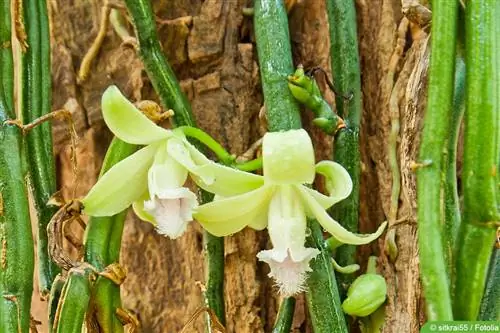
Propagate
A big advantage of vanilla plants are the different methods of propagation. Once you have purchased a he althy specimen, you can use it to grow additional vanilla plants. Growing from seeds is usually not possible in Germany because there are no seeds available and the plants first have to flower, which can take five to ten years. For this reason, propagation via cuttings has become established, which is easy for hobby gardeners to implement. The following cuttings are suitable:
- Head cuttings
- Root cuttings
Propagation is particularly recommended over spring or summer as the temperature can be optimized more easily. The cuttings should ideally be 40 centimeters long so that a larger plant can quickly form from them. With the following instructions you will succeed in propagation:
- Completely remove the leaves at the bottom of the cutting
- prepare a container with potting soil
- Place the cutting with the bare side into the substrate
- Fix the cutting with a climbing aid
- Slightly moisten the growing soil
- A spray bottle is suitable for this
- Cover cutting including pot with transparent film
- alternatively use polytunnel
- keep the substrate moist over the next few weeks
- choose a bright location
- Temperature: about 25°C
- avoid direct sun
- wait until a new shoot has developed
- then repot and care for as usual
Stimulating flowering
One of the most difficult and time-consuming aspects of the vanilla plant are the flowers. A vanilla plant only blooms after a few years, when its tendrils have reached a length of eight to ten meters. On average, with good care and an ideal location, it takes up to five years. It is more difficult to find the right time for the actual flower formation. As soon as the tendrils have reached the necessary length, they must hang or lie freely and must no longer be tied up. If they are tied, they do not form flower buds. With a bit of luck, you will be able to enjoy vanilla blossoms after a few years.

Fertilize
If you also want to use the vanilla plant to enjoy the delicious spice, you will have to do the fertilization on your own. The reason: The necessary pollinators do not live in Central Europe. Vanilla plants are pollinated exclusively by Melipona bees and hummingbirds. Our native bees have no use for the pollen. Fortunately, they can carry out this task themselves during the flowering period. This can be done as follows:
- each vanilla flower only blooms once
- it opens in the morning hours
- after opening it must be pollinated within 12 hours
- otherwise it will wither without bearing fruit
- carefully cut the flower from top to bottom
- use a sharpened stick (e.g. toothpick, ice cream stick)
- open the flower slightly
- pick up the pollen at the flower opening with the stick
- lead into the calyx
- close the flower carefully and pull out the stick
- carefully rub in the pollen
Since vanilla flowers don't bloom at the same time, you have to keep checking and pollinating them if you want to harvest as many vanilla beans as possible later. Since the vanilla plant does not have a regular flowering period in our latitudes, you have to wait between six and ten months until the flower develops into a pod.
Harvesting
The pods are harvested when the green color takes on a yellowish tone. In order to use the pods as a spice, you must first ferment and dry them:
- Wash the pods quickly in hot water
- lay protected, warm and moist in the blazing sun
- alternatively, wrap in a permanently damp cloth
- wait until pods have shrunk and turned brown-red
- Peppers should also be slightly oily
- Unpacking the pods
- switch regularly between sun and shade for drying
- You determine the duration of the intervals yourself
- after you turn black, they are usable
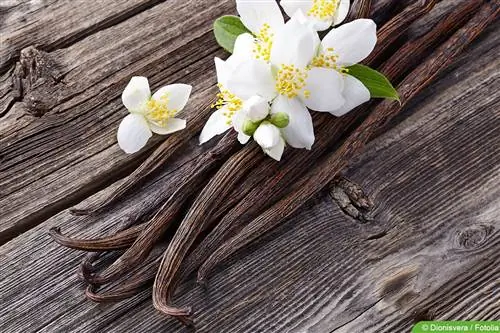
Tip:
Do not only use the pulp of the vanilla beans. After scraping the pod, cut it into thin slices or dry it in the oven until it can be ground into a spice powder.
Wintering
Vanilla planifolia is not overwintered in any special way. It is watered a little less so that the root ball does not dry out. All nutrient additions are completely stopped. What is important over the winter is a permanently heated location that does not fall below 20°C and does not dry out. The humidity mentioned above is particularly important over this period.
Note:
If it is too dry and cool in the winter quarters, scale insect infestation can occur. Remove these using appropriate home remedies and then optimize the conditions at the location.

